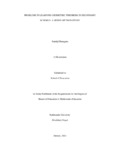
Please use this identifier to cite or link to this item:
https://hdl.handle.net/20.500.14301/370| Title: | Problems in Learning Geometric Theorems in Secondary Schools: A Mixed Method Study |
| Authors: | Dhungana, Sandip |
| Citation: | Dhungana, S.(2021).Problems in learning geometric Theorems in secondary schools: A mixed method study |
| Issue Date: | Jan-2021 |
| Publisher: | Kathmandu University School of Education |
| School: | SOED |
| Department: | DOSE |
| Level: | Masters |
| Program: | Master of Education in Mathematics Education |
| Abstract: | Theorems and their proofs are centred not only on Geometry but also on Mathematics education.The study of theorems and their proofs can create coherent reasoning and thinking aptitudes in Mathematics learners. The portion which is considered as a milestone of Geometry and overall Mathematics is being a matter of hurdle in Nepalese schools. The problem in learning Geometry theorems in secondary schools is not only decreasing the achievement of students in the examination but also reducing the students’ interest in Mathematics. In my context, I have also experienced different types of difficulties in learning Geometry theorems both as a student and teacher. The abstract nature of theorems and its logical understanding were the major obstacles for me while learning. Therefore, the first purpose of this study was to measure the problems faced by the students in learning Geometry theorems at the secondary level and the second one was to investigate the reasons behind the problems. The explanatory sequential mixed-method study was carried out to figure out the problems in learning Geometry theorems and their possible reasons. The study was conducted in Tokha Municipality of Kathmandu district where 270 Grade IX and X students and 27 Mathematics teachers of the same level participated in the survey from seven different community high schools. Questionnaires with five-point Likert scales under five different headings (Content of Geometry, teaching-learning activities, school administration, teachers’ professional development and evaluations techniques) were used as research tools for the survey which was analysed by using SPSS. The survey tool (structured questionnaire) was finalized after the pilot testing. Similarly, an interview was conducted to know the possible reasons behind the problems found in the first phase study. For the qualitative setting, two students of secondary level, two Mathematics teachers, an educationist, and a curriculum officer, who had spent their long time in the field of school Mathematics, were chosen. Both qualitative and quantitative data were collected through online mode in this study. The analysis of students’ responses collected through survey revealed that students felt Geometry theorems less practicable in their real-life; theoretical learning seemed more difficult than solving problems; teachers used fewer ICT tools in Mathematics, teachers hardly responded to all the students, and rarely focused on group works, and schools did not have the facility of Math lab and lack of internet access to clarify the concepts of Mathematics. From the students’ responses, it was also found that there was no significant difference (p > 0.05) on the problems faced by the students based on their genders and found a significant difference (p < 0.05) in learning Geometry theorems based on their Grades. Additionally, correlation analysis was performed to see the relation between the different indicators (like content, school administration, teaching-learning materials, evaluation, and teacher’s professional development) used in the survey tools. The correlation analysis of students’ responses showed that there was slightly a positive correlation between the problems in the content of Geometry and teaching-learning activity whereas problems in the content of Geometry had a weak positive correlation with evaluation technique and a moderate correlation between the problems in teaching-learning activity and school administration. The analysis also showed the moderate correlation between the problems in the teaching-learning activity and evaluation technique and moderate correlation between school administration and evaluation technique. On the other hand, the analysis of teachers’ responses indicated that students felt more complicated in learning Geometry theorems than other contents of Geometry and could not find the connections between the theorems. It was also found that the theorems were less connected to the students’ daily practices as they were afraid of it. Moreover, they felt difficult to transfer the statements into the figures and prove them theoretically. Teachers’ responses also showed that students were less interested in learning Geometry theorems and the majority of them left this section assuming that it does not affect their score. The poor foundation in school Mathematics, traditional algorithmic problem-solving approach of teaching and learning with rote memorization, few uses of manipulative in Geometry and inadequate training for the teachers in Geometry theorems were some of the problems discovered from the teachers’ responses in learning Geometry theorems. It was also found that teachers’ teaching experiences did not show any significant differences (p > α = 0.05) in learning Geometry theorems for secondary students. The qualitative section in this study concluded the study with the themes; the impact of teacher-students’ relation in theorem learning, teaching-learning strategies in Geometry theorems, the internet and ICT tools in theorem learning, de-contextualization in Geometry learning and impact of teachers’ training on Geometrytheorems learning which deals with the reasons behind the problems disclosed from the first phase study. In this regard, this research study was oriented to explore the problems in learning Geometry theorems in Nepali Mathematics education, thereby giving an insight to the stakeholders of school mathematics to redesign an effective curriculum and teaching-learning activities. |
| URI: | https://hdl.handle.net/20.500.14301/370 |
| Appears in Collections: | Dissertation |
Files in This Item:
| File | Description | Size | Format | |
|---|---|---|---|---|
| PROBLEMS IN LEARNING GEOMETRIC THEOREMS IN SECONDARY SCHOOLS_SANDIP DHUNGANA (2).pdf | 1.42 MB | Adobe PDF |  View/Open |
Items in DSpace are protected by copyright, with all rights reserved, unless otherwise indicated.